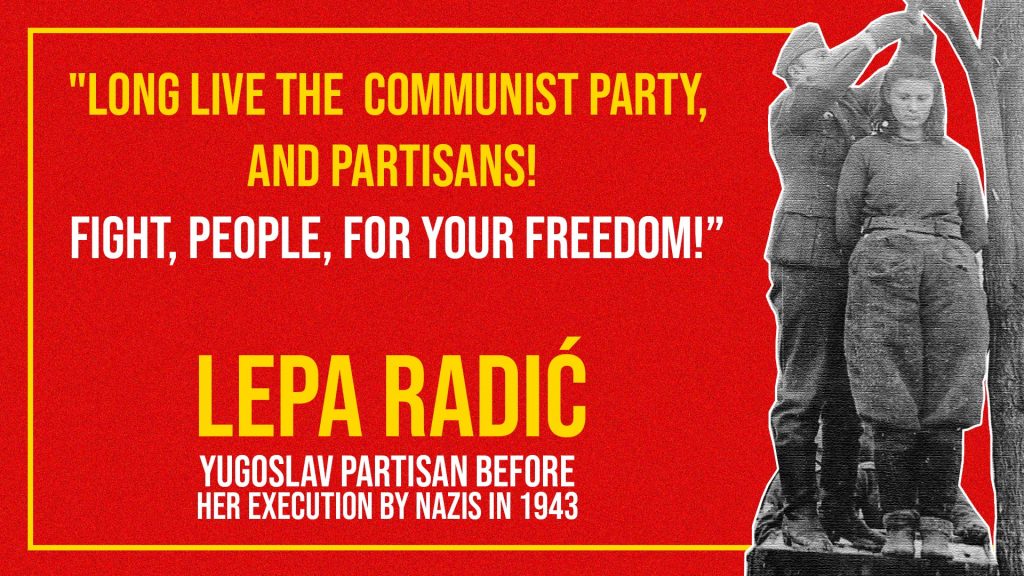
 ‘Fight People for Freedom, Don’t Surrender’ were the last words of Lepa Radic, a Serb freedom fighter girl who was hanged publicly by Nazi Germans on Feb 8, 1943 when she was only 17.
‘Fight People for Freedom, Don’t Surrender’ were the last words of Lepa Radic, a Serb freedom fighter girl who was hanged publicly by Nazi Germans on Feb 8, 1943 when she was only 17.
On February 8, 1943, Bosnian member of Yugoslav partisans, Lepa Svetozara Radić was executed at the age of 17 by the Nazis during World War II. She was part of the 7th partisan company of the 2nd Krajiški Detachment, and took part in Kozara Offensive and Battle of Neretva before she was captured by the Nazis. After failing to extract any information from her about the partisans, she was sentenced to death by hanging.
With the noose around her neck, she cried out: “Long live the Communist Party, and partisans! Fight, people, for your freedom! Do not surrender to the evildoers! I will be killed, but there are those who will avenge me!”
 Nazi troops offered her a way out of the gallows by revealing her comrades’ and leaders’ identities. She responded that she was not a traitor and that they would reveal themselves when they avenged her death.
Nazi troops offered her a way out of the gallows by revealing her comrades’ and leaders’ identities. She responded that she was not a traitor and that they would reveal themselves when they avenged her death.
She was posthumously awarded the Order of the People’s Hero on 20 December 1951, for her role in the resistance movement against the Axis powers—becoming the youngest recipient at the time.
Early life
Radić was born to a Bosnian Serb family on 19 December 1925 in the village of Gašnica near Bosanska Gradiška. After graduation from the elementary school in the nearby Bistrica, she attended the first grade of Women’s School of Crafts in Bosanska Krupa and completed the remaining grades at school in Bosanska Gradiška.
As a pupil, Lepa emphasized hard work, seriousness, and was also interested in reading advanced literature. She developed her core positions under the strong influence of her uncle Vladeta Radić, who was involved in the labor movement.
 Starting with becoming a member of the League of Communist Youth of Yugoslavia (SKOJ), she eventually joined the Communist Party of Yugoslavia in 1941 at the age of 15.
Starting with becoming a member of the League of Communist Youth of Yugoslavia (SKOJ), she eventually joined the Communist Party of Yugoslavia in 1941 at the age of 15.
World War II
On 10 April 1941, after the invasion of Yugoslavia, the Axis powers established the Independent State of Croatia, which included Bosanska Gradiška and surrounding areas.
In November 1941, Lepa Radić and other family members were arrested by the Ustaše, but with the help of undercover partisan associates, Lepa and her sister Dara managed to escape from prison on 23 December 1941. Following her escape, she joined the 7th partisan company of the 2nd Krajiški Detachment.
In February 1943 Lepa Radić was responsible for transporting the wounded in the battle of Neretva to a shelter. During the fight she was captured and moved to Bosanska Krupa where, after torture for several days in an attempt to extract information, she was sentenced to death by hanging.
In her last moments at the scaffold, the Germans offered to spare her life, in return for the names of the Communist Party leaders and members in the shelter, but she refused their offer with the words: “I am not a traitor of my people. Those whom you are asking about will reveal themselves when they have succeeded in wiping out all you evildoers, to the last man.” Lepa Radić was publicly executed. The Nazis were never able to break her heroic spirit.
Serbian Resistance
While the Germans maintained tight control over the roads and towns, they could not control the remote, mountainous regions of war-torn Yugoslavia. In those towering mountains, Serbian resistance forces began to emerge from the rubble. This surge of resistance to the Axis largely divided into two main groups – the Chetniks and the Partisans.
 The Chetniks were led by former Yugoslav Army Colonel Dragoljub Mihailovic, who served under the Yugoslav royalist government in exile. The Chetniks were united in name only and were comprised of various sub-groups whose interests didn’t always align. Some were fervently anti-German while others cooperated with the invaders at times. But what virtually all Chetniks did manage to agree on was their nationalist desire to ensure the survival of the Serbian population and their loyalty to the old Yugoslav monarchy.
The Chetniks were led by former Yugoslav Army Colonel Dragoljub Mihailovic, who served under the Yugoslav royalist government in exile. The Chetniks were united in name only and were comprised of various sub-groups whose interests didn’t always align. Some were fervently anti-German while others cooperated with the invaders at times. But what virtually all Chetniks did manage to agree on was their nationalist desire to ensure the survival of the Serbian population and their loyalty to the old Yugoslav monarchy.
The Partisans were diametrically opposed to the Chetniks, as their group was fiercely communist. Their leader was Josip Broz “Tito,” the head of the underground Communist Party of Yugoslavia (KPJ). Under Tito, the Partisans’ overarching goal was to establish an independent socialist Yugoslav state by overthrowing the Axis powers.
It was into this dense, tangled conflict that young Lepa Radić threw herself when she joined the Partisans in December 1941.
Due to their dissident activities, the entire Radic family was arrested in November 1941 by the Ustashe, the fascist Nazi-puppet government operating in Yugoslavia’s Independent State of Croatia.
___________________
Source: All That’s Interesting, Historic Mysteries, Young Communist League, Women Documented, Peoples Dispatch, Wikipedia